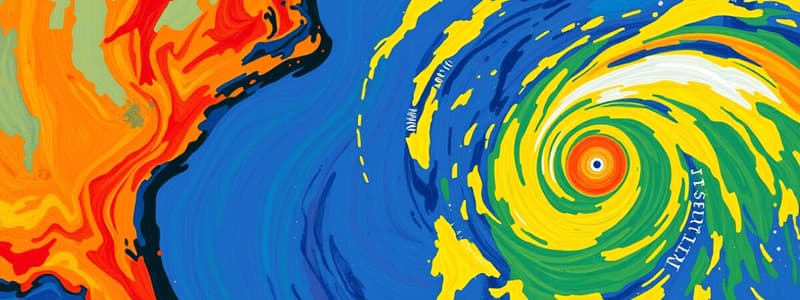Podcast
Questions and Answers
What is a recommended action to take during a blizzard?
What is a recommended action to take during a blizzard?
- Go outside for fresh air.
- Turn on all outdoor lights.
- Stay indoors and avoid travel. (correct)
- Roam around to find help.
What can happen if someone does not bundle up during a blizzard?
What can happen if someone does not bundle up during a blizzard?
- They will remain unaffected.
- They might experience hypothermia. (correct)
- They may need to evacuate.
- They will get sunburned.
Which of the following best describes hypothermia?
Which of the following best describes hypothermia?
- A condition that results from overheating.
- A temporary cold-related illness.
- An allergic reaction to cold weather.
- A state where body temperature falls to dangerous levels. (correct)
What should you do if you receive an evacuation order during a hurricane?
What should you do if you receive an evacuation order during a hurricane?
How do hurricanes typically differ from tornadoes?
How do hurricanes typically differ from tornadoes?
What is the primary benefit of tracking hurricanes?
What is the primary benefit of tracking hurricanes?
Which of the following is NOT a precaution typically recommended during blizzards?
Which of the following is NOT a precaution typically recommended during blizzards?
What should you do if you must go out during a blizzard?
What should you do if you must go out during a blizzard?
What is the most dangerous type of flooding?
What is the most dangerous type of flooding?
Which item is essential to keep in an emergency kit for natural disasters?
Which item is essential to keep in an emergency kit for natural disasters?
What is a key action to take when a flood watch is issued?
What is a key action to take when a flood watch is issued?
What should you NOT do during a flood?
What should you NOT do during a flood?
How can you stay safe during an earthquake?
How can you stay safe during an earthquake?
What is a potential consequence of severe hypothermia?
What is a potential consequence of severe hypothermia?
Which preventive measure is effective against frostbite?
Which preventive measure is effective against frostbite?
What should you do during a thunderstorm if you are indoors?
What should you do during a thunderstorm if you are indoors?
What indicates that a severe storm is currently occurring?
What indicates that a severe storm is currently occurring?
Which agency is responsible for tracking storms and issuing bulletins to the public?
Which agency is responsible for tracking storms and issuing bulletins to the public?
What is the most dangerous element of a thunderstorm?
What is the most dangerous element of a thunderstorm?
Which of the following is a recommended action if you are outdoors during a thunderstorm?
Which of the following is a recommended action if you are outdoors during a thunderstorm?
What should you do if your area is under a storm warning?
What should you do if your area is under a storm warning?
How does technology assist in tracking weather emergencies?
How does technology assist in tracking weather emergencies?
What is a storm watch an indication of?
What is a storm watch an indication of?
Flashcards are hidden until you start studying
Study Notes
Hurricanes
- Storm clouds can extend over hundreds of miles; the calm center is called the eye.
- Wind speeds increase the power of hurricanes; they typically occur in late summer or early fall.
- Hurricanes form slowly compared to tornadoes, allowing for advance warning and tracking by the National Weather Service (NWS).
- Safety measures include boarding up windows, closing storm shutters, and bringing outdoor items inside.
- Stay informed through TV or radio; evacuation may be necessary in severe cases.
- If no evacuation is ordered, shelter-in-place by staying indoors, away from windows and doors.
Blizzards
- Blizzards can last from one hour to several days, making travel hazardous and disrupting essential supplies.
- The safest place during a blizzard is indoors due to reduced visibility of less than 500 feet.
- Protect yourself from hypothermia and frostbite by bundling up in layers of clothing, including wind- and waterproof outerwear.
- Avoid wandering in blizzard conditions; use landmarks to navigate or stay put until help arrives, especially near downed power lines.
Natural Disasters
- Natural disasters are dramatic events driven by Earth's processes, causing health and safety risks; they include floods and earthquakes.
- Planning ahead is crucial, keeping an emergency kit stocked with fresh water, a radio, a flashlight, batteries, blankets, canned food, and a first-aid kit.
Floods
- Floods occur when water rises and overflows onto dry land, caused by hurricanes or heavy rainfall.
- Flash floods are sudden and extremely dangerous, with the power to sweep away vehicles and structures.
- During a flood watch, move to higher ground and listen to battery-powered radios for updates.
- If a flood warning is issued, evacuate immediately; avoid traversing floodwaters.
Weather Emergencies
- Weather emergencies arise from atmospheric changes, often occurring with little warning and impacting safety and health.
- The NWS tracks severe weather events and issues bulletins, which include watches (potential storms) and warnings (active emergencies).
- Technology like satellites and computers aids in weather prediction, enhancing public safety through early warnings.
Thunderstorms and Lightning
- Thunderstorms are more frequent in warm weather, with lightning being the most dangerous aspect.
- Seek shelter when thunderstorms approach; remain indoors and avoid using wired telephones.
- Outdoors, find an enclosed building or metal vehicle with windows shut to stay safe from lightning.
Studying That Suits You
Use AI to generate personalized quizzes and flashcards to suit your learning preferences.




